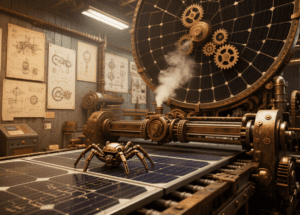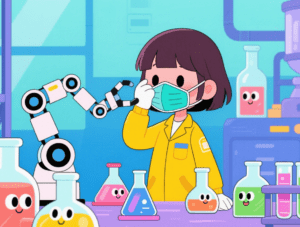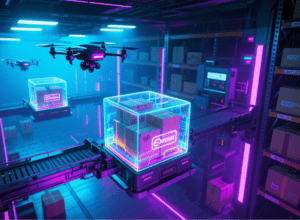Table of Contents
ToggleNew Energy Production Line Automation: Driving Efficiency Revolution in Lithium Batteries and Photovoltaics

Driven by the “dual carbon goals” and the wave of energy transition, new energy production line automation has become the core engine for industries like lithium batteries and photovoltaics to break through “capacity bottlenecks, precision barriers, and safety risks”. From lithium battery cell lamination to photovoltaic module string welding, and from pole piece cutting to glass packaging, automation technologies are reconstructing the “efficiency ceiling” of new energy manufacturing through three breakthroughs: “micron-level control + intelligent detection + digital twin”, promoting the industry’s leap from “scale expansion” to “quality upgrading”.
I. Technical Characteristics of New Energy Automation: Industry Breakthroughs in Three Dimensions
The special attributes of new energy products (such as the flammability and explosiveness of lithium batteries, and the fragility of photovoltaic modules) impose strict requirements of “high precision, high safety, and high reliability” on automation equipment:
1. Hardware Layer: Precision Execution and Safety Design
- Core Technologies for Lithium Battery Production Lines:
- Cell lamination: Laser cutting + robotic arm lamination (precision ±0.05mm) replaces traditional die-cutting processes, controlling pole piece burrs within ≤5μm (traditional processes allow ≤20μm), reducing battery short-circuit risks.
- Tab welding: Pulsed thermal pressure welding + infrared temperature measurement (precision ±1℃) controls welding temperature at 220–250℃ to avoid over-welding (fusing) or virtual welding (high contact resistance).
- Core Technologies for Photovoltaic Production Lines:
- Wafer cutting: Multi-wire cutting machine + tension closed-loop control (precision ±1μm) maintains the thickness of 182mm silicon wafers at 130μm±5μm, with a breakage rate <0.3% (traditional processes have a 1.5% breakage rate).
- Module string welding: High-speed string welding machine + visual positioning (precision ±5μm) achieves a welding efficiency of 1,200 pieces/hour, with solder strip offset ≤0.1mm.
2. Software Layer: Intelligent Control and Safety Traceability
- Lithium Battery BMS Collaboration:
- The production line communicates in real time with the Battery Management System (BMS), collecting 50+ parameters such as pole piece resistance and welding temperature, establishing a full-chain traceability from cells to modules to Packs, and supporting thermal runaway risk warnings (e.g., 72-hour advance alarm for abnormal cell resistance).
- Photovoltaic EL Detection:
- Electroluminescence (EL) detection system + AI recognition algorithm automatically marks defects such as hidden wafer cracks (width ≥50μm) and virtual welding, with a detection efficiency of 1,200 pieces/hour and a missed detection rate <0.1%.
- Safety Interlock System:
- Lithium battery injection processes integrate flammable gas detection (LEL<25%) + explosion-proof design (ATEX Zone 1), automatically activating exhaust + shutdown when organic solvent concentrations exceed standards to ensure production safety.
3. Detection Technology: Defect Interception and Performance Assurance
- Lithium Battery X-Ray Detection:
- Micron-level X-ray imaging (resolution ≤5μm) detects internal pole piece alignment (deviation ≤0.1mm) and electrolyte distribution uniformity in cells, replacing traditional disassembly detection (efficiency increased by 10 times).
- Photovoltaic IV Testing:
- Current-voltage characteristic testing + temperature compensation (precision ±0.5℃) accurately calculates module power (error <0.5%), ensuring each module meets factory standards.
II. Scenario Penetration: End-to-End Automation in Lithium Batteries and Photovoltaics
The value of new energy automation delivers differentiated breakthroughs in two key sectors:
1. Lithium Battery Production Lines: The Precision Battle from Pole Pieces to Packs
- Pole Piece Manufacturing:
- Coating process: Slit coating + thickness closed-loop control (precision ±1μm) ensures uniform coating of positive and negative electrode materials, avoiding inconsistent battery capacity.
- Cutting process: Circular blade cutting + edge dust removal (dust removal efficiency 99.9%) controls pole piece edge burrs within ≤5μm, preventing diaphragm puncture and short circuits.
- Cell Assembly:
- Winding/lamination all-in-one machine: Six-axis robot + force control system (pressure control ±0.5N) achieves 0.05mm-level alignment for square cells, increasing battery cycle life by 20%.
- Pack Integration:
- Module welding: Laser galvanometer welding + visual positioning (precision ±0.02mm) completes high-precision connection between tabs and busbars, with contact resistance ≤1mΩ.
- Case Data: After automating a CATL production line, cell yield increased from 95% to 99.5%, capacity rose by 45%, and unit energy consumption dropped by 30%.
2. Photovoltaic Module Production Lines: Efficiency Revolution from Wafers to Power Stations
- Wafer Processing:
- Diamond wire cutting + cutting fluid circulation system reduces wafer thickness from 156μm to 130μm, increases material utilization from 45% to 55%, and lowers silicon material costs by ¥15 million per GW.
- Cell Production:
- Screen printing + AI visual inspection controls grid line width at 25μm±2μm, increasing cell conversion efficiency from 22% to 24.5%.
- Module Assembly:
- Fully automated string welding-lamination-framing: High-speed string welding machine (1,200 pieces/hour) + EL detection (online rejection of defective pieces) + framing robot (positioning precision ±0.1mm), with daily capacity of 5,000 pieces (500W modules) per production line.
- Data Comparison: After automating a LONGi base, module power deviation narrowed from ±3% to ±1%, labor costs dropped by 70%, and delivery cycles shortened from 15 days to 7 days.
III. Case Study: “Automated Breakthrough” of 4680 Cylindrical Batteries
When mass-producing Tesla’s 4680 batteries, a new energy enterprise faced process challenges posed by “large size and high energy density”:
Pre-Transformation Pain Points
- Traditional cylindrical battery production lines couldn’t adapt to 4680 batteries (diameter 46mm, height 80mm), with tab welding yield only 85% (serious over-welding/virtual welding).
- During winding of large-size cells, pole piece alignment deviation ≥0.2mm caused battery internal resistance inconsistency >5%, affecting range.
- Low manual inspection efficiency failed to meet the full-inspection needs of 4680 batteries (high safety risk).
Automation Solution
- Hardware Upgrades:
- Tab welding: Custom laser welding head + galvanometer system achieves 0.1mm-level spot control, combined with infrared temperature measurement (precision ±1℃), welding temperature fluctuation ≤5℃, yield increased to 99.5%.
- Winding process: High-precision servo motor + tension closed-loop (control precision ±0.1N), pole piece alignment deviation ≤0.05mm, internal resistance inconsistency <2%.
- Detection System:
- X-Ray 3D imaging (resolution 3μm) online detects internal pole piece layers and alignment in cells, full-inspection efficiency 2,000 pieces/hour.
- Short-circuit test: 1000V high-voltage detection + flying probe test ensures cell insulation (resistance >100MΩ).
- Digital Twin:
- Simulates winding and welding processes in a virtual environment, optimizes parameters in advance (e.g., reduces winding speed from 50rpm to 30rpm to minimize pole piece wrinkles), trial production yield increased from 70% to 90%.
Post-Transformation Achievements
- Quality: Cell yield from 85% to 99.5%, internal resistance inconsistency <2%, cycle life (1C charge/discharge) reaches 5,000 times (30% increase).
- Efficiency: Daily capacity per production line from 10,000 to 30,000 pieces (200% increase), meeting demands of Tesla’s Shanghai factory.
- Cost: Labor reduced from 30 to 8 workers per shift, labor costs down 73%, unit energy consumption down 25%.
- Safety: Passed UL 1642 certification, thermal runaway risk reduced by 90%, compliant with electric vehicle safety standards.
IV. Three Key Steps for Implementing New Energy Automation
From solution design to stable operation, three challenges must be overcome: “precision, safety, capacity”:
1. Requirement Diagnosis: Technical Benchmarking and Risk Identification
- Precision Calculation:
- Quantify process requirements (e.g., lithium battery lamination precision ±0.05mm, photovoltaic string welding precision ±5μm) to reverse-select equipment (e.g., robots with repeat positioning precision ±0.02mm).
- Safety Assessment:
- Identify high-risk processes (e.g., lithium battery injection, photovoltaic glass handling), design explosion-proof and anti-breakage solutions (e.g., injection rooms with explosion-proof rating Zone 1, glass handling using vacuum adsorption + force control).
- Capacity Planning:
- Based on expansion plans (e.g., from 10GWh to 50GWh within 3 years), design equipment redundancy (30% spare capacity per unit) to avoid “secondary transformation” costs.
2. Solution Design: Digital Twin and Safety Preview
- Virtual Commissioning:
- Simulate lithium battery winding processes 1:1 on Siemens Digital Twin platform, test the impact of different tensions (1–5N) on pole piece alignment, and identify optimal parameters (best alignment at 2.5N tension).
- Safety Simulation:
- Use ANSYS to simulate photovoltaic module drops (1m height), optimize framing fixture design (add buffer silicone pads), reducing glass breakage rate from 5% to 0.5%.
- Energy Consumption Simulation:
- Integrate production line energy consumption models, compare power consumption of different solutions (e.g., servo motor solutions save 30% energy compared to stepper motors), and select the optimal energy path.
3. Debugging and Optimization: From “Functional” to “Efficient”
- Precision Calibration:
- Use laser interferometers (precision ±0.1μm) to calibrate robotic arm positioning in lithium battery lamination processes, ensuring lamination precision ±0.05mm.
- Use microscopes (500x) to calibrate solder strip offset in photovoltaic string welding processes, adjust visual system parameters (light source angle, camera focal length), keeping offset ≤5μm.
- Process Iteration:
- Establish a parameter optimization closed loop, automatically analyze the correlation between yield and parameters every 1,000 cells/1,000 modules produced (e.g., every 10℃ increase in welding temperature reduces yield by 1.2%), and reverse-optimize processes.
- Safety Verification:
- Conduct 30-day continuous operation tests on lithium battery production lines to verify the response speed of explosion-proof systems (shutdown ≤1 second when flammable gas concentration exceeds standards), ensuring safety and reliability.
V. Future Trends: AI and Low-Carbon 重塑 New Energy Manufacturing
The next frontier for new energy automation is the deep integration of “intelligence + green”:
- AI process optimization: Analyze 100,000+ batches of data through Transformer architecture, automatically predict optimal lamination tension (e.g., dynamically adjust based on pole piece thickness and humidity), increasing yield by another 1–2%.
- Digital twin operation and maintenance: Equipment digital twins synchronize physical states in real time, predict bearing wear in advance (remaining life prediction error <5%), reducing maintenance costs by 30%.
- Low-carbon manufacturing: Equipment integrates carbon footprint calculation modules, automatically recommending the lowest-energy production solutions (e.g., running high-energy processes during low-night electricity prices), reducing carbon emissions per product by 15%.
- Hydrogen fuel cell automation: Develop hydrogen fuel cell plate coating equipment (precision ±1μm) and membrane electrode assembly robots (force control ±0.1N) to promote hydrogen energy industrialization.
The essence of new energy production line automation is “solving energy transition challenges with technology”—it not only improves capacity and yield but also drives continuous breakthroughs in lithium battery energy density and photovoltaic conversion efficiency through precise control and intelligent detection, accelerating the realization of “dual carbon goals”. As more enterprises break through the technical barriers of “new energy precision”, automation will upgrade from a “production tool” to a “technical lever”, 撬动 the entire energy industry’s efficiency revolution.
“toilet assembly” “assembly computer” “bathroom faucet components”








